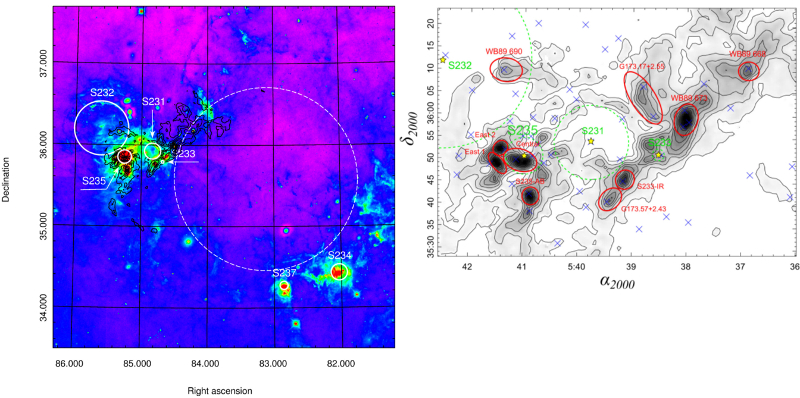| EPoS Contribution |
|
Impact of Expanding Shells on High and Low Mass Star Formation in Giant Molecular Cloud G174+2.5
Maria Kirsanova INASAN, Moscow, RU | |
| Interstellar gas clouds appear as interconnected networks of elongated filamentary structures. Recent numerical simulations show that multiple compression episodes of gas clouds by supersonic waves or shells are needed to produce molecular filaments with dense clumps and potential sites of star formation. We present the results of a long-term study of the giant molecular cloud G174+2.5. We find that the prevailing majority of young stellar clusters reside on peripheries of expanding shells. O-type stars visible at optical wavelengths have formed extended HII regions S231, S232 and S235. Early B-type stars are more deeply embedded in the parental molecular material, and surrounded by compact HII regions, namely S233, S235A and S235C. Filamentary-shaped molecular gas is observed on the periphery of the ionized regions and appears as broken molecular shells on large-scale maps of CO emission. Young embedded stellar clusters are concentrated in these shells. The formation of five embedded clusters around the HII region S235 was triggered, or at least accelerated by the expansion of the ionized gas. Compression driven by the HII region S233 could also have impacted nearby star formation. We find a candidate massive embedded star on the periphery of S235, which could be the first example of a second-generation massive star which is more massive than the source of ionization for the HII region. Beside this intriguing example, there are no confirmed high-mass protostellar candidates in the embedded clusters in G174+2.5. A significant fraction of molecular gas in G174+2.5 is concentrated in a single filament, WB673, with a length of 25 parsec. The filament projected location is between the HII region S231 and a possible supernova remnant, and could be a good example of a region exposed to multiple compression events from expanding shells. We conclude that star formation in the embedded clusters in G174+2.5 is controlled, or at least organized by, expanding shells produced by high-mass stars belonging to the giant molecular cloud. Large-scale galactic supersonic waves and/or supernovae probably have made an impact on high-mass star formation in the G174+2.5 molecular cloud. | |
 | |
| Caption: Right: Image at 22μm by WISE shown by color. Black contours represent 13CO emission of giant molecular cloud G174+2.5. White circles show optical HII regions. White dashed circle shows unidentified bubble-shaped nebula which probably is supernova remnant. Left: Distribution of column density of 13CO toward G174+2.5. Blue crosses denote the positions of the IRAS sources. Bold red ellipses mark molecular clumps with embedded young star clusters. Dashed circles mark HII regions. Star symbols show the position of stars ionizing the HII regions. | |
| Collaborators: A. Sobolev, UrFU, RU D. Ladeyschikov, UrFU, RU P. Boley, MIPT, RU D. Wiebe, INASAN, RU |
Key publication
Suggested Session: Filaments |

